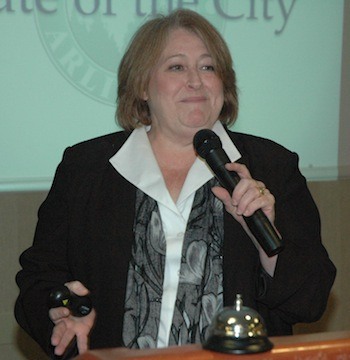SMOKEY POINT — “I told you that last year would be the year of transportation,” Arlington Mayor Barbara Tolbert told those in attendance at the Arlington-Smokey Point Chamber of Commerce’s Jan. 14 luncheon. “And how true that was. Every year, our city sets goals for itself.”
Tolbert used her State of the City address to the Chamber for 2014 to highlight not only the city’s successes over the course of the past year, but also to offer area residents a forecast of what they could expect for the year ahead. As but one example, she noted that, just as the Arlington Fire Department had taken part in a regional fire service study with six other agencies in 2013, so too will the Arlington Police Department be part of a 12-week public safety study in 2014.
“We want to make sure it’s structured in the best way possible,” said Tolbert, who credited Arlington Police with already having taken steps to address the city’s crime rates and neighborhood safety last year, through a variety of measures including a crackdown on panhandling that started in November and “has seen visible results.”
Likewise, while Tolbert gushed about finally being able to drive on the north-south connection of Airport Boulevard, she also acknowledged that State Route 531 needs to be widened.
“And in August, the city’s citizens voted for a Transportation Benefit District to fund and fix 126 failing road segments that the city is responsible for, so thank you for that,” Tolbert said on Jan. 14. “In 2014, we’re looking to have 67th Avenue finally finished. I know it’s been a bit rough, this week especially, but we hope to have it open by late spring or early summer.”
With the Stillaguamish River reaching flood levels briefly during the weekend prior to the luncheon, Tolbert also credited grant funds with providing drainage at Prairie Creek. Although the Rotary Club of Arlington has been among those groups and individuals who have already heavily contributed to the eventual renovation of Haller Park, Tolbert would welcome even more partners on that project.
“Arlington is a full-service city,” Tolbert said. “We have public safety services in police and fire, and utility services in water and sewer. Part of the first impression we make on people who see Arlington is in how we maintain those and other assets, from the 4 million square feet of pavement at the airport to the 16 miles of roadside mowing that we have to do. We’re a city that’s rich in assets, but it takes finances to keep those up.”
Tolbert added that sustaining such assets has been even more difficult during a recession, during which the city also received an audit finding in 2011, for its low reserve fund balance.
“We’re supposed to have one month of operating income and 8 percent of our income from taxes, which comes out to about $1.8 million,” Tolbert said. “At one point, we were down to $77. Two years later, we’ve made significant progress, by restructuring and streamlining our departments, but we’ve lost 19 staff members along the way.”
Even with measures such as lower cost technology and what Tolbert described as ruthless budget cuts, she reported that the reserve fund balance is only at “about half a million dollars,” which is one reason why she’s joining the call of City Council members for a property tax levy lid lift, which will be put to Arlington voters on April 22.
“Of 20 cities in Snohomish County, we have the lowest property tax rate, and that’s historically been the case,” Tolbert said. “In 2001, I-747 limited the amount of property tax that could be collected without a vote of the people, and it was capped below the rate of inflation.”
Tolbert characterized the city of Arlington as dependent on its sales and property taxes, and blamed the streamlining of state sales taxes in 2008 with tipping the balance of Arlington’s dependency toward property taxes, since it shifted the collection of sales taxes to their points of product delivery.
“We brought out our Band-Aids, because we were unsure how long this economic downturn would last,” Tolbert said. “In reducing our expenses, we were looking ahead one year at a time. Now we’re looking ahead five years at a time, but we’re still using those short-term Band-Aids, which for 2014 have eliminated all contributions to our equipment replacement fund.”
To shore up the city’s staffing and maintain both its public safety services and its variety of quality-of-life amenities, Tolbert is asking Arlington voters to agree to an increase in the regular property tax levy of 58 cents, bringing it up to a rate of $1.955 per $1,000 of assessed valuation, which she estimated would amount to an increase of $8.40 per month for a medium-sized homeowner.
“This will also move the city into compliance with its reserve fund requirements within seven years,” Tolbert said. “And instead of having the lowest property tax rate in Snohomish County, we’ll have the sixth-lowest. The future is up to you, because as voters, we should decide.”
Tolbert confirmed one attendee’s math, calculating that this adds up to a roughly 40 percent increase in the property tax rate, but she defended it as vitally necessary.
“We did look for a lower rate,” Tolbert said. “There is no more fat to be trimmed. We’ve already reduced our payroll by almost $2 million over the past four years. We’ve cut everything that we can. We need to replace our fire apparatus and police staffing. If you want a budget with a lot of fat, I’m not your mayor. This is a rate that’s not out of line with other cities our size in the county.”
Looking further ahead, Tolbert predicted slow but steady economic growth for Arlington, but warned its residents and businesses that they shouldn’t expect the economy to grow at the levels that it’s done in the past.







